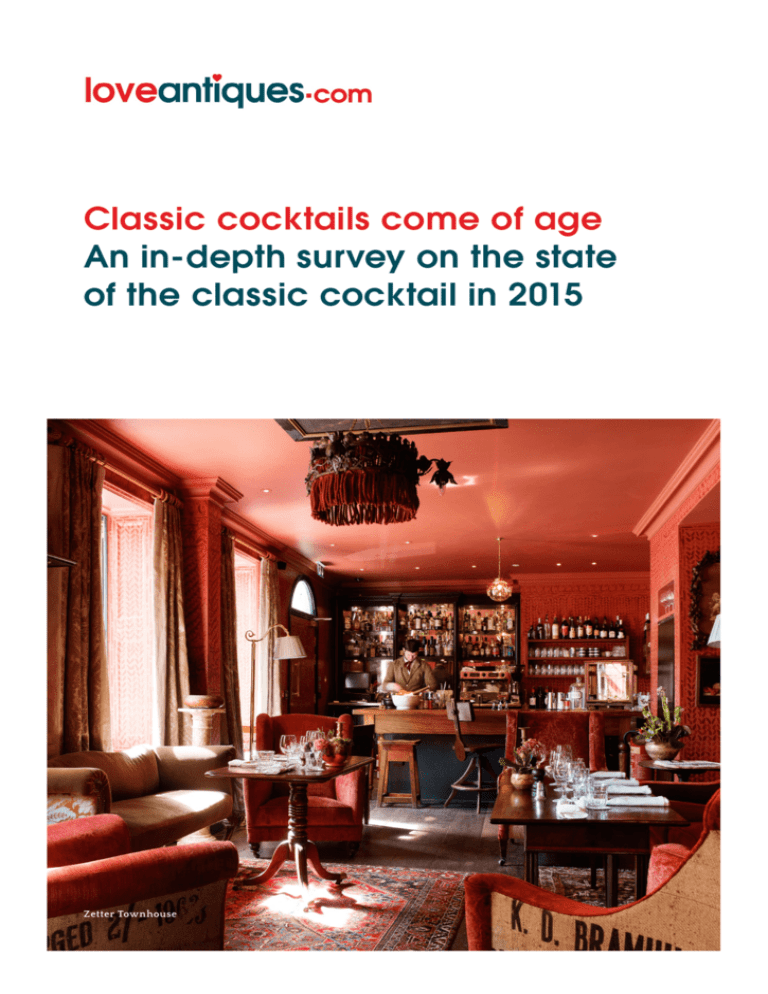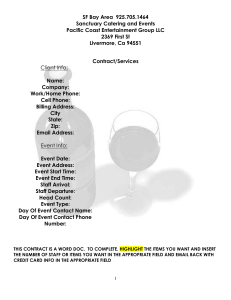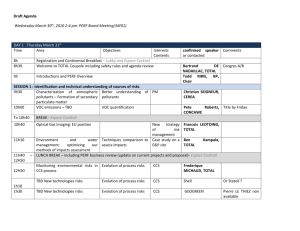Classic cocktails come of age
advertisement

Classic cocktails come of age An in-depth survey on the state of the classic cocktail in 2015 Zetter Townhouse We trawled 40 of London’s finest cocktail bars to report on the very latest news and views from the world of the mixologist. Yes, it’s been tough work, but someone has to do it. There’s never been a better time in histor y to be a cocktail drinker. Restaurants and bars can no longer pass off belowstandard booze with sugar and a gaudy umbrella. Creative bartenders have worked hard to revive the art of cocktail mixing, so any establishment worth the salt on its Margarita glass now ser ves a sophisticated selection of spirited beauties. Given our passion for heritage at LoveA ntiques , cultural antiquities and style icons of days gone by, it’s natural we’re celebrating the comeback of the classic cocktail. To mark the rebirth of 42 treasures, ranging from the 1850s’ Brandy Daisy to the Common Market (created in 1973 to mark Britain’s entr y into the EEC), we’ve devised The 2015 Classic Cocktail Map Of Britain. The map highlights 159 bars, up and down the UK, with a reputation for mixing classics to perfection, or with an innovative, contemporar y twist. Our self less reporters worked noon, night (and even later night), to delve deep into the drinking culture of London, capital of the classic cocktail. Talking to 40 of London’s top mixologists brought fascinating results. We discovered an industr y that’s recaptured its groove. Recipes from the Prohibition Era are being reworked, using futuristic technolog y and interesting new ingredients, to make the f lavours of the 19th and 20th centuries make sense to the palates of the 21st. 2 Our Classic Cocktail Survey London 2015 revealed: 95% 92% 84% of bartenders have seen an increase in demand for classics over the past few years. of bartenders produce their own infusions, syrups, bitters or purées. 87% of bartenders agreed with the statement: ‘The Classics can be improved ’. of bartenders believe that preser ving the original presentation of a classic cocktail is important. The bars we visited were in Central London 17 Shoreditch 7 The Old-Fashioned 36.2% is by far the most popular classic in the bars sur veyed, followed by the Martini (19.1%), Mojito (8.5%), Margarita, Negroni, Sazerac (6.4% each), Manhattan, Cosmopolitan (4.3% each), Daquiri, Planter’s Punch and the Mai Tai (2.1% each). West London 5 North London 5 The City 3 Docklands 1 3 What defines a classic cocktail? Staying power. Plantation holders in old Havana drank the same Mojitos as today’s accountants on a night out. The Southern Belles of yesterday share the love of a good frozen Julep with today’s girls on a hen night. Sharing the taste for Martini with Frank Sinatra and James Bond is a major part of the charm. In 1806, a reader wrote to an upmarket New York newspaper to ask what the word cocktail meant. ‘Cocktail,’ the editor replied, ‘ is a stimulating liquour, composed of spirits of any kind, sugar, water and bitters…it’s supposed to be an excellent electioneering potion.’ The earliest cocktails were simple, but spirited, with the base spirit packing a punch. Few include more than five ingredients and many use just three. In the Prohibition, cocktails such as the Gin R ickey were designed to mask the illicit alcohol, so when that age ended, cocktail quaffers developed a liking for drinks that tasted strong, such as the Old-Fashioned. Tastes have changed through the eras, from the sweet and sour Margarita to the bittersweet Negroni, the savour ysour Bloody Mar y and the fruity-creamy Piña Colada. Newly-professional bartenders are now turning to old recipe books to unearth long-lost gems and reinvent vintage favourites. 4 How do London’s mixologists handle classic cocktails? “If you don’t know the classics, how can you make any other cocktail?” ER IK LOR INCZ Head Bartender A merican Bar at The Savoy Hotel, London Reverence towards the classics varies among bartenders. Erik Lorincz at the Savoy’s A merican Bar, London’s oldest cocktail establishment, and Thamas at Rules restaurant, once frequented by Charles Dickens, view classics as the cornerstone of the cocktail industr y. The A merican Bar ser ves an Original Sazerac, made from the original ingredients: 1858 Sazerac de Forge brandy, 1950s Pernod absinthe and Peychaud ’s bitters from the early 1900s. Management at Barrio East in Shoreditch and nearby NOL A agree that you can’t improve on a classic recipe. ‘If a customer orders a classic, that’s exactly what they should get,’ they say. In other newer bars, such as the London Cocktail Club, thought has gone into crafting a list that combines classics with contemporar y cocktails, including the Pornstar Martini. Daniel Stoilaki, Head Bartender at Mint Leaf, believes classic cocktails are “the base of the drinks industr y.” He says that customers and bartenders are richer for knowing their classics, as it makes them more willing to experiment and understand how alcohol f lavours bring out the best in each other. To Hebe R ichardson and Nate Brown of the Merchant House, it is the style of a classic that makes it interesting. Rather than sticking to the precise approach of David Embur y’s The Fine A rt of Mixing Drinks (1948), they give their team freedom to express themselves with original twists. Steve Mankeltow, Manager at Chelsea’s Goat, agrees that the classic cocktail recipes are as ‘concepts,’ which can be adapted to suit our modern palates. “If Harr y Craddock, David Embur y and Gar y Regan all have different recipes for a ‘classic’, which is correct?” he points out. 5 “You take the classics and play around with them… you take an Old Fashioned and you can do anything you want to it — as long as it tastes right!” PA O L O T E L E S C A Manager The Ape & Bird Merchant House 6 Is old and new the ultimate classic combination? Paolo Telesca thinks it’s vital for a bar to develop its own personality, reflected in its drinks menu. Order an Old Fashioned in The Ape & Bird and you’ ll be offered their speciality, a Rye London Old Fashioned, made with r ye whiskey, f lamed orange peel and A maro London. Stephen Pennack, Head Barman at The Zetter Townhouse in Clerkenwell, presides over a plush bar, full of antique sofas, carpets, gramophones and paintings, including one of ‘The Great Aunt,’ affectionately known as ‘Wilhelmina.’ To resonate with the décor, his cocktails are made with traditional English ingredients, such as nettle, dandelion, burdock, port and sherr y. Head Bartender at The A rtesian, A lex K ratena says: ‘Mixing a cocktail is like a work of art. Both the bartender and the customer need to unfold and explore its f lavours.’ Fred of the Portobello Star believes that classics should only ever be changed for a reason – for example, to complement food – but has no problem with experimentation, which is how the classics came about in the first place. Maria Jordan, of Canvas Bar in Old Street maintains that the original f lavours of a classic must still be present in any new interpretations. Referring to their Smoked Old Fashioned, she says it is: ‘a combination of elegance and sophistication, yet it upholds the classic taste of the original cocktail. Putting a twist to a classic is an art and getting it right is absolutely essential.’ 7 “It is hard to improve on a classic. But interpretations and twists can be good. In the same way a talented musician riffs on a standard tune and makes it his own.” EDMUND W EIL Owner Nightjar Zetter Townhouse 8 Old School, High Tech Living Ventures, a Manchesterbased company behind some 25 bars, including The Alchemist in the City of London, believes in innovation on the technical side of bartending. Behind the scenes, their mixologists use various proteins and chemicals to bring a drink closer to its ‘perfect’ edition. Shane Dobson, Head Bartender at The A lchemist, tells us their Smoky Old Fashioned takes 10 minutes to reach optimum dilution, giving it intense depth of f lavour. The Zetter Townhouse collaborates with 69 Colebrooke Row in producing bespoke ingredients which bring out the best in their cocktails. Using modern techniques such as centrifuging, sous-vide cooking and rotar y evaporating to extract f lavours, their lab produces ingredients such as rose-essence sugar cubes to tie up their cognac-based champagne cocktail with a f lourish. 9 Twist and Shout Lab Bar manager Marco Piroli sees it as his duty to push boundaries. He’ ll ser ve you a rum matched with peanut butter or bourbon with marshmallow. Your Mint Julep will be made from Bovril, maple syrup, Gentleman Jack, fig, mint and bitters, ser ved with a garnish of beef jerky. It might surprise some drinkers, but he insists the f lavours go wonderfully well together. Peter at The London Cocktail Club, and Charlotte Ir vine of Trader Vic’s, are also groundbreakers, but agree that if you’re twisting a classic cocktail, it should be renamed. Think the Espresso Martini and Sunset Negroni. The pros agree that the customer must come first and if they ask for a particular cocktail, that’s what they should get. According to Nate Brown of the Merchant House: ‘The palates of the 1920s are a million miles from modern tastes. It’s important to us to adapt the way in which a classic is put together, in order to bring the most out of the premium spirits that we use in our bar.’ This is a view shared by Maria Jordan and James Huertas of Canvas Bar and Trailer Happiness respectively. James points out that the quality of alcohol has drastically improved, so less sugar is needed today. 10 Should classic cocktails be presented in a classical way? “If it looks good, it tastes good.” SH A NE DOBSON Head Bartender The A lchemist Daniel at Mint Leaf believes classic presentation is important, although he allows experimentation with garnishes on his bar. He is especially keen on garnishing whisky drinks with fresh chocolate. He believes the drink itself will only account for 90% of the customer’s experience and the final 10% can be reached only through exceptional presentation. Ruben, of Zenna Bar, weights the visual experience of a cocktail at closer to 50%. Living Ventures’ top bartenders pass through a training program called ‘The Top 100,’ where they are encouraged to experiment and innovate with ever y aspect of a drink. Many of them enter cocktail competitions, where the visual impact of a drink is scored as much as the way it tastes. As a result, like many Living Ventures bars, The A lchemist is a highly theatrical place. Nonetheless, 85% of the bartenders we spoke to placed great importance on ser ving the classics in the expected way – for instance, Mint Juleps in a silver cup and Martinis in a Martini glass (stemmed, inverted bowl). George Mazur, of The Macbeth in Hoxton, firmly believes that the taste of a drink changes depending on the glassware used, so he places great importance on original presentation of a classic. This may not be all you think it is, though. Before you go moaning that your champagne cocktail isn’t handed to you in a f lute, bear in mind they were historically ser ved in a tumbler with ice. 11 “[Classical Presentation] is extremely important… without it, it’s like having a beautiful outfit and not wearing the right shoes.” M A R I A JOR DA N PR & Marketing Manager Canvas Bar Merchant House 12 Are classic cocktails more popular than ever? An overwhelming majority of 95% of bartenders surveyed answered this question with a yes. “Certain drinks articulate a certain lifestyle.” NAT E BROW N Co-owner Merchant House Some pointed to cyclical trends to explain this. Others cited the popularity of shows such as Mad Men, Boardwalk Empire and Sex A nd The City for the upturn, thanks to their cocktail-downing stars. Shane at The A lchemist puts it down to the prevalence of better-educated bartenders. He describes them as ‘ knowledge freaks,’ obsessed by f lavour combinations, as well as spirits and bitters they hadn’t come across before. He sees it as their job to educate customers and sees the cocktail industr y becoming more accessible, as new drinkers work their way through the classics. Beatrice Bradsell of Pink Chihuahua at El Camión in Soho draws a connection between make-at-home cocktail kits, such as those provided by Shaken Cocktails on a parcel subscription ser vice and the knowledge level of the capital ’s cocktail drinkers. James Triffo at NOL A believes the resurgence began around 10 years ago with the publication of books by Esquire magazine’s cocktail correspondent David Wondrich, followed by Mixologist: The Journal of the A merican Cocktail Volume 1 by Jared McDaniel Brown and A nistatia Miller. Lifestyle writers and the emerging blogosphere fed into social media and it was then ‘only a matter of time before mainstream bars caught up, recognising the profit margins are greater on cocktails than beer and wine.’ Nate Brown and Stephen Pennack see the renewed interest in classic cocktails as a product of our economic climate. Nate claims that ‘people want heritage and value for their money these days, and classics play to that.’ 13 Stephen looks back at the Golden Era of classic cocktail creation as a time of prohibition and war. Now more people can afford to drink, they’re looking to drink fewer drinks, of better quality. “Tastes follow a cyclical pattern of human behaviour.” SIIM PEETER SIMISKER Polpo There is an undeniable mytholog y around the classics, and in the opinion of Thamas at Rules, customers want to feel they’re buying into that heritage – luxur y or decadence, depending on the cocktail. Robert Gaggl, of Connaught, sees the rise of Speakeasy-inspired bars as leading customers towards tr ying the classics. The few who disagreed that interest in classics has increased, such as Sergio at R ise 46, were typically bartenders who pushed their own concoctions and had established a reputation for doing so, which might explain the discrepancy. Canvas Bar’s Smoky Old Fashioned 14 Do artisanal spirits and made-inhouse bitters, infusions and purées create new opportunities for interpreting the classics? The attitude towards artisanal spirits, which have become increasingly available over the past few years, is over whelmingly positive in London’s cocktail bars. This is especially seen in the number of gins stocked on the capital ’s bar shelves. In the words of Martin Baeta, a bartender at Good Godfrey’s in the Waldorf Hilton: ‘Four years ago, we stocked maybe 70 brands of gin…now we have closer to 250!” In his native Portugal, a countr y not known for its gin, there are now a number of artisanal distilleries, devoted to producing fine-quality gin, such as Sharish, Big Boss and Templus. He doesn’t believe that this gin obsession will last forever, though. His tip for the next big spirit is rum, a trend for which the Merchant House seems ideally equipped with its selection of some 500 gins and rums. A ll bartenders owned up to being hesitant when it comes to making their own spirits, apart from James of Trailer Happiness, where they make their own batch of rum, and Fred of Portobello Star, where the Ginstitute supplies the bar with premium quality gin. Erik Lorincz summed up the popular attitude when he said that he prefers to leave that to the experts, because they have a far better understanding of the f lavour compounds which make up a spirit. It is then the bartender’s job to work out how to complement them with bitters, syrups and other alcohols. Marco Piroli of Lab Bar concurs. “We prefer to get spirits from the people who have been making them for 100s of years. They have the expertise and the physical space to produce excellent results.” 15 “Modern techniques and technologies allow us to match flavours in new ways.” ST EPHEN PEN NACK Head Barman The Zetter Townhouse Zetter Townhouse 16 “While I love trying someone’s home made bitters I think it’s more of a novelty than of commercial interest.” ST E V E M A N K ELTOW Goat While making their own spirits might be a hurdle too far, many bartenders in London’s cocktail bars are encouraged to experiment with a myriad of their own purées, infusions and bitters. Many bartenders are welcoming the challenges presented by mixolog y, which will lead them towards unique creations and variations. Martin, of Good Godfrey’s, makes his own syrups, which he adds to his classics. Order a Daquiri and he’ ll offer to add a dash of his lime and tobacco-infused syrup. He and his comrade Paolo at The Ape & Bird see such individual ingredients as a unique weapon in a barman’s arsenal. Paolo and his team ser ve lemony cocktails with their own thyme-infused syrup, just one element which makes his bar stand out from the competition. Going against the grain, Steve Manktelow of Goat states: “While I love tr ying someone’s home-made bitters, I think it’s more of a novelty than of commercial interest.” At the Merchant House, Hebe tells us that in ever y drink ser ved there is at least one home-made component. She feels this is important because customers are not looking for a carbon copy of a classic, but for a bartender’s interpretation of it, a view shared by Mint Leaf ’s Daniel, who is working towards producing his own bitters and barrel-aged cocktails, such as a Patron Negroni and a Gin Negroni. Beatrice Bradsell believes that while an infusion can aid a classic, it doesn’t necessarily make it better. In her mind, they should only be used when they work. Incidentally at Pink Chihuahua, they make a Sangrita fresh ever y day. Guillaume, of 69 Colebrooke Row, urges caution, pointing out that infusions and syrups can have a substantial effect of altering the taste of a cocktail and when a classic’s taste is completely altered to the point where it’s no longer recognisable, it’s not a classic anymore. 17 It’s hard to imagine what cocktail-drinking legends such as Winston Churchill and Ernest Hemingway would have made of the results of our Classic Cocktail Survey: London 2015. New-fangled mixing techniques and ingredients such as rose-infused sugar cubes may have baffled them – but we bet they wouldn’t have been able to resist. London’s cocktail scene is experiencing something of a renaissance, and the classics are at the heart of that. 18 Classic cocktails come of age An in-depth survey on the state of the classic cocktail in 2015 Room 102, 134-146 Curtain Road, London EC2A 3A R Call 020 8045 3745 Follow twitter.com/loveantiques facebook.com/loveantiquescom




